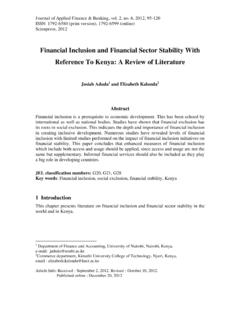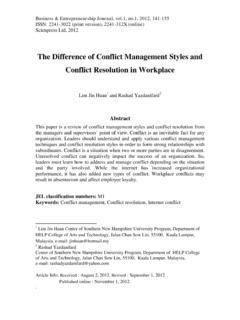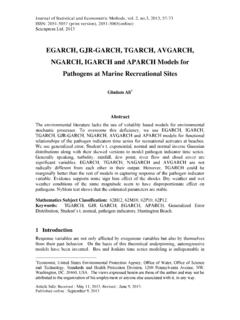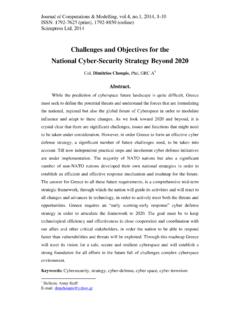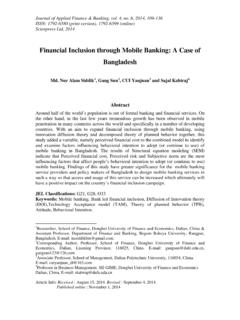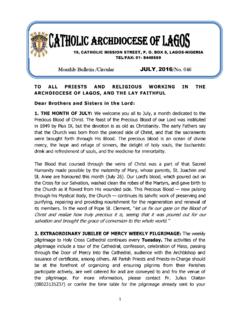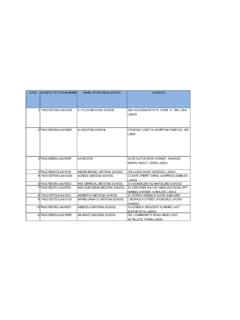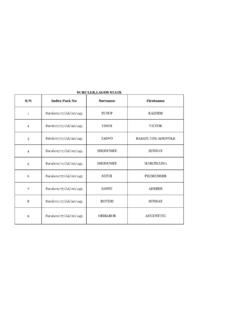Transcription of Application of Geophysical and Geotechnical …
1 Journal of Earth Sciences and Geotechnical Engineering, , , 2011, 87-100 ISSN: 1792-9040 (print), 1792-9660 (online) International Scientific Press, 2011 Application of Geophysical and Geotechnical Methods to Site Characterization for Construction Purposes at Ikoyi, Lagos, Nigeria Oyedele1, S. Oladele1 and O. Adedoyin1 Abstract An integrated Geophysical and Geotechnical survey was carried out in a proposed engineering site at Ikoyi, Lagos, Nigeria. The survey aimed to image shallow subsurface with a view to evaluate the stratigraphy and competency of the shallow formation as foundation materials. Geotechnical investigation involving Cone Penetration Testing (CPT) and Standard Penetration Testing (SPT) were carried out on the site.
2 Geophysical technique involving Vertical Electrical Sounding (VES) was also implemented and the data were processed, inverted and interpreted. Geophysical and Geotechnical tests showed good agreement. Four to five subsurface layers were delineated within the study area: the topsoil loose sand, peat/clay, sandy clay, sand and clay. This indicates good correlation with the soil layers in bore logs. The existence of loose sand, peat and clay near at the surface is capable of being inimical to building structures. The subsurface layers up to the depth of 16 m are mechanically unstable with low penetration resistance value which may not serve as good foundation materials.
3 Shallow foundation is 1 Department of Geosciences, University of Lagos, Lagos, Nigeria Article Info: Revised : December 12, 2011. Published online : January 31, 2012 88 Application of Geophysical and Geotechnical considered unsuitable for the intended building. In view of unsuitability of shallow foundation in this area, structures in this area should be safely founded in competent and mechanically stable coarse sand through pilling. Keywords: Geophysics, SPT, CPT, VES, Resistivity, foundations 1 Introduction The figures of failures of buildings throughout the nation have increased in recent times.
4 The necessity for site characterization for construction purposes has therefore become very vital so as to prevent loss of valuable lives and properties that always accompany such failure. Some general reasons why buildings may be susceptible to collapse have been advanced, which include poor quality of building materials, salinity, and old age of buildings. Less frequently mention is the subsurface conditions of the ground on which the buildings are sited. The design of a structure which is safe, durable and has low maintenance costs depends upon an adequate understanding of the nature of the ground on which such building is located.
5 Site characterization usually provides subsurface information that assists civil engineers in the design of foundation of civil engineering structures. The primary purpose of all site investigations is to obtain the data needed for analysis and design. The most challenging part of these investigations is to collect only those data needed with the least amount of money and in the least amount of time. The proposed Site is located at Ikoyi in the south-western part of Lagos State, south west Nigeria, lying between latitudes 6 25' 00" and 6 27' 11" North; 3 25'00" and 3 26' 8" East (Figure.)
6 1). It is a zone of coastal creeks and lagoons which is almost encompassed by the Lagos lagoon system. Ikoyi area of Lagos is located near the eastern margin of the Nigerian sector of the Benin-basin, within , Oyedele, S. Oladele and O. Adedoyin 89 the Western Nigeria coastal zone which consists largely of coastal creeks and lagoons developed by barrier beaches associated with sand deposition underlain by recent deposits which vary from the littoral and lagoon sediments to the coastal belt and alluvial deposits of the major rivers (Adeyemi, 1972). Sub-soil investigations involving Geophysical and Geotechnical methods have been carried out in the study area.
7 The non-destructive mode of stratigraphy determination of Geophysical methods made them necessary and adequate while the Geotechnical investigation is essential to have an adequate knowledge of the engineering properties of the subsoil materials that would have direct interaction with the proposed structure on the site. In the last decade, the involvement of geophysics and Geotechnical methods in civil engineering has become a promising approach (Adepelumi et al 2009; Adepelumi, A. A. and Olorunfemi, M. O. (2000)). The Cone Penetration Test (CPT) which allows for the soil type to be determined from the measured values of cone resistance and sleeve friction was employed to provide valuable and continuous information regarding the soil strength with depth.
8 The resistance parameters were used to classify soil strata and to estimate strength. The Standard Penetration Test (SPT) identified the soil stratification and engineering properties of soil layers. Due to the soft nature of soil deposits in Ikoyi, the CPT is considered a perfect tool for subsurface investigation and site characterization. This investigation will be useful in determining the nature and engineering properties of the proposed site for proper foundation design for the proposed structure. This study therefore employed Geophysical investigation in conjunction with in-situ soil testing to provide information on the subsurface sequence, competence and structural disposition with a view to capture geo-engineering information of the subsurface that are inimical to engineering projects.
9 90 Application of Geophysical and Geotechnical Figure 1: Map of the study area showing locations of data acquisition BH 2 , Oyedele, S. Oladele and O. Adedoyin 91 2 Geology of the study area The Lagos metropolis is the area of land around the only inlet of the sea into the extensive lagoon system. Stratigraphically, the basin is divided into Abeokuta Formation, Ilaro Formation, Coastal Plain Sands and Recent Alluvium sediments (Jones and Hockey, 1964). Deposition of Cretaceous sequence in the eastern Dahomey basin began with the Abeokuta Group, consisting of the Ise, Afowo and Araromi Formations (Omatsola and Adegoke 1981).
10 The Ise Formation, the oldest, unconformably overlies the basement complex and consists of conglomerates and sandstones at base and in turn overlain by coarse to medium grained sands with interbedded kaolinite. Overlying the Ise Formation is the Afowo Formation, which is composed of coarse to medium grained sandstones with variable but thick interbedded shales, siltstones and claystone. The Araromi Formation overlies the Afowo Formation and is the youngest Cretaceous sediment in the eastern Dahomey basin (Omatsola and Adegoke, 1981). It is composed of fine to medium grained sandstone overlain by shales, siltstone with interbedded limestone, marl and lignite.
